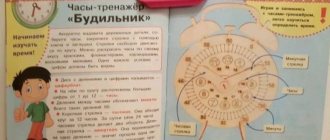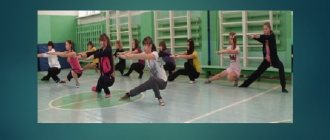Counting down
Arriving at school, these children already know how to not only count from one to ten, but can start counting from any number. For example, they can count from three to six, seven, ten, etc. They know, for example, that after five comes six, and after seven comes eight, and so on. They can count all this in reverse order, from ten, eight, five to one, or say that before five there is four, and before seven there is six.
And these are precisely the skills and knowledge without which a child cannot even learn correct addition and subtraction within ten, not to mention more complex arithmetic operations.
If he did not acquire them before school, he begins to experience difficulties from the very first days and can easily become unsuccessful.
Does this mean that such children are incapable and unintelligent? Not at all.
Outside of school work, for example, in play or when doing a practical task, these children act much smarter, more active and quick-witted than in their studies; they are often no different from their comrades. And the most interesting thing is that they do not always experience difficulties in their studies.
Many of them can calculate where exactly to write, that is, how many cells should be retreated from above and to the side, and can correctly copy an example or sentence. Difficulties in learning arise for them only in those types of educational activities that require active mental work and mental effort. For example, perform a calculation in an arithmetic example or correctly pose a question in a problem.
Why does this happen? Why are these kids behind in their development?
We talked about how a child always learns. But this does not mean at all that therefore you should not take care of his mental development. No, his life must be organized so that he receives enough food for thought, so that he constantly learns new things, so that he has new interests, new questions. Otherwise, he will not acquire the knowledge that forms the basis of his work at school, and will study poorly.
This means that the only way remains is to give him now the knowledge and skills that he did not acquire before school.
But this is where the difficulty arises. A child will not be able to do the work, will not begin to actively think and reflect if he does not know how to do this. Such work is difficult for him, and therefore unpleasant. And therefore he will avoid it in every possible way, wait for a hint, try to guess the answer or copy it off.
This means that it is necessary to transform learning for him from difficult and unpleasant work into something pleasant and interesting. How to do this will be discussed in the next chapter.
← Upbringing
13.06.2018
Notes on mathematics in the preparatory group of preschool educational institutions. Count within 10
Summary of a mathematics lesson in the preparatory group “Journey to the Queen of Numbers.”
Author: Alexandra Nikolaevna Smirnova, teacher at MBDOU “Kindergarten No. 104”, Ivanovo
Lesson topic: “Journey to the Queen of Numbers.”
Goals : To consolidate the ability to use quantitative and ordinal counting within 10. Objectives: Educational:
• - Practice counting within 10 in forward and reverse order;
• — consolidate the concepts: “previous”, “next”, “neighbors” of the named number; • — Consolidate knowledge about the sequence of days of the week and seasons. Developmental:
• develop attention, imagination, creativity, speech.
Educational:
• - Cultivate a friendly attitude towards each other, a sense of mutual assistance.
• — To develop independence, the ability to understand a learning task and carry it out independently. • — Cultivate interest in mathematical studies. Preliminary work with children: • Guessing riddles, solving logical problems, solving simple arithmetic problems. Equipment: - cards with tasks, a checkered sheet of paper and a pencil according to the number of children, counting sticks, a chest with a surprise.
Course of the lesson:
Educator: Do you guys like traveling? (Children's answers). Today we will go on a journey to the Queen of Numbers. She needs our help, because evil robbers have stolen 3 numbers. Shall we help the Queen find them? (children's answers). Interesting tasks will await us. You will have to show your knowledge, skills and intelligence. Are you ready to go on this exciting journey? (children's answers) Educator: Well done! And now you will find out how we will get there. Guys, each of you has a sheet of paper with dots and numbers on your table. Your task is to connect the numbers in the correct order. (train)
What did you get? (compare with a board). Well done! Let's go on a trip. Guys, while you and I are on the train to the Queen of Numbers, let's tune in and practice. Let's get ready? First, let's remember: - Guys, what day of the week is it today? (Thursday) - What day of the week was yesterday? (Wednesday) - What day of the week will it be tomorrow? (Friday) - How many days are there in the week? (seven) - What days are the weekends? (Saturday and Sunday) How many seasons are there (4) How many months does each season have (3) How many months are there in the year (12) Now, I will name a number of words, and you will have to name the extra word. Winter, Wednesday, spring, summer, autumn (Wednesday) One, two, three, circle, four (circle) Plus, minus, Friday, equal (Friday) And now I will ask questions, listen carefully. If the table is higher than the chair, then the chair? (Below the table) If the road is wider than the path, then is it a path? (Already roads) If the ruler is longer than the pencil, then the pencil? (Shorter than a ruler) If the rope is thicker than the thread, then the thread? (Thinner than a rope) If a sister is older than a brother, then is the brother? (Younger than sister) Educator: Well done guys! Well, here we are. See the letter here. Let's read it. "Letter. Dear Guys! I have a problem, evil robbers stole my numbers, without them I can’t build a number series, I hope that you will help me find the missing numbers. The robbers have prepared tasks for you and said that for each correct solution of the tasks they will return numbers. I hope for your help, I can’t do it alone.” Educator: Guys, can we help the Queen? (children's answers) And so, the first task: The robbers have prepared problems for us, let's solve them: A puppy is sitting on the porch, warming his fluffy side. Another one came running and sat down next to him. How many puppies are there? (2) Antoshka fell into the snow, followed by Irinka. And behind her is Seryozhka, and behind him is Marinka. And then Ignat fell. How many children are there in the snow? (5) Grandma Masha has a grandson, Fyodor the Cat Pushok. Dog Buddy. How many grandchildren does grandma have? (1) 4 birds are sitting on a tree: 2 sparrows, the rest are crows. How many crows? (2) There were 6 mushrooms in the basket, 1 mushroom turned out to be inedible and was thrown away. How many mushrooms are left? (5) 5 roses bloomed on the bush. Mom cut 3 pieces, how many are left? (2) There were 5 red cups and 1 blue cup on the shelf. How many cups were there? (6) There are 8 tomatoes ripe on the bush. Four tomatoes were picked. How much is left? (4) Educator: Guys, it says here that if we solve the last problem correctly, we will get the first number that was stolen by the robbers. Listen carefully. Mom put cabbage pies in the oven. For Natasha, Kolya, Vova, the pies are already ready, and the cat dragged one more pie under the bench. Moreover, Mom needs to take five out of the oven. If you can, help - Count the pies! (9) Educator: Well done guys, you completed this task, and the robbers return one number to us. Now let's rest a little and move on. Physical education lesson: Let's jump and gallop! One two three four five! Let's jump and jump! (Jumping in place.) The right side bent. (Tilts the body left and right.) One, two, three. Left side bent. One two Three. Now let’s raise our hands (Hands up.) And reach for the cloud. Let's sit on the path, (Sit down on the floor.) We'll stretch our legs. Let's bend our right leg, (Bend our legs at the knee.) One, two, three! Let's bend the left leg, One, two, three. They raised their legs high (Raised their legs up.) And held them for a while. They shook their heads (Move their heads.) And everyone stood up together. (They stood up.) Educator: Well, you and I have had a little rest, we need to move on. Look at the tables, the robbers have prepared another task for you, if you solve it correctly, they will return another number to us. Ready? (children's answers) “Composition of numbers.” Guys, each of you has pictures of houses, in each house there are as many residents as are indicated on the roof, for example, 7 residents live in a house, 5 have already moved in, how many people will live in another apartment? (2). Guys, do you understand the task? (children's answers). Children complete tasks, composition of numbers.
Educator : Well done guys, you completed this task too, the robbers are returning another number to us. Warm-up: Now all the children should stand up, slowly raise their hands, clench their fingers, then unclench their hands, hold their hands down and stand like that. We all rested a little (lean forward and shake our arms) and went on the path. (steps in place or in a circle) Educator: Guys, we have already returned two numbers to the Queen of Numbers, we have one last task left, is everyone ready to cope with it? (children's answers) Look at the geometric shapes on our table, we need to build a house from them, but not just build, first we need to guess, and only then build our house. 1. Four corners and four sides, They look exactly like sisters. You can’t roll him into the goal like a ball, And he won’t start galloping after you. The figure is familiar to many guys. Did you recognize him? After all, this is... (Square)
Let's put a square. This will be the foundation of our house. 2. My three sides can be of different lengths. Where the sides meet - the angle is obtained. What happened? Look! After all, there are also three corners. Look at me, say my name. (Triangle)
We put a triangle. This is the roof of our house. 3. We stretched the square and presented it to the eye, Who did it look like or something very similar? Not a brick, not a triangle - Became a square... (rectangle)
Let's create a rectangle. This will be the pipe for our house. — What else is missing in our house? (doors and windows) 4. I have no corners And I look like a saucer, Like a medal, like a pancake, Like an aspen leaf. I am an old friend to people. They call me (circle)
Let's make a circle. Guys, let's take two circles, these will be our windows. 5. Trace the whole brick with chalk on the asphalt, And you will get a figure - You, of course, are familiar with it. (Rectangle)
Let's create a rectangle. This will be the door for our house. Let's see what we got
- Well done guys, you completed all the tasks that the robbers prepared for you, and the Queen of Numbers wants to thank you. Letter from the Queen of Numbers. "Dear friends! Thank you so much for your help! You did an excellent job with all the tasks. Absolute precision and order reign in my mathematical kingdom. You, my young mathematicians, in gratitude from all the inhabitants of my country and from me personally, are awarded gold medals for your intelligence, ingenuity and determination!”
We recommend watching:
Summary of GCD for children of the preparatory group. How to be able to count well Mathematics lesson in the preparatory group. Notes Notes of the final lesson in mathematics in the preparatory group Notes of OD on FEMP in the preparatory group “Journey into the world of mathematics”
Similar articles:
Summary of mathematics lessons in the preparatory group. Pentagon
Summary of mathematics lessons in the preparatory group. Repetition of what has been learned in the senior group
Abstract of GCD in mathematics in the preparatory group. Solving logical problems
Abstract of GCD in mathematics in the preparatory group on the topic: Area
Abstract of GCD in mathematics in the preparatory group. Tangram
From 1 to 10
To begin with, children are told a simple count, calling numbers from 1 to 10 one by one. You can start counting anything that arouses interest in the baby. During a walk, you and your son can count the cars parked at the entrance, the number of bows in a friend’s hair, the candies in the vase or the yoghurts in the refrigerator. You should try to interest your daughter in the number of items that interest her: balloons from the seller, hares on the page of her favorite book, dolls on the shelf in the nursery, etc.
Very often, parents involve their children in the world of mathematics at ease. For example, going up to her apartment, a mother asks her child to count the steps. Along the way, he draws attention to the numbers that mark the numbering of floors on the walls. It is useful to draw children's attention to the numbering of vehicles. “A little more and our bus number 9 will arrive. Look, isn’t that him?”
A supermarket can generally be regarded as a repository for a mass of teaching material. “How many bars of soap did we put in the cart? Is there chocolate here like you like? Let's take two tiles." It will also be useful to draw your child’s attention to the storage room number. “Look at the door number 7, and on the key tag there is also the number 7. The girl has 4 oranges in the bag, and do you want this fruit?”
Almost all children love the game of hide and seek. Parents should take advantage of this and combine business with pleasure.
“I count to five, but I can’t count to ten. One, two, three, four, five - I’m going to look.” At 3 years old, the baby will count, focusing on the intonation of his parents, and his words in pronunciation will bear little resemblance to the names of numbers, but by the age of 5, speech will become extremely clear.
“Stay out of my life” and 6 more popular phrases from children that break a parent’s heart
There are several special games and techniques that will tell parents how to teach a 4-year-old child to count. But most parents teach this in passing, but every day.
“How many fingers do you have on your right hand, and how many on your left? Count the dog's legs. What floor do we live on?
Learning addition
You can also unobtrusively teach your baby how to do addition. The easiest way to teach a child to solve examples up to 10 is on subjects that are of great interest to him. If a preschooler loves candy, they can be safely used as teaching material. “Mom had 2 candies, she offered one to dad, how many did mom eat?” You can continue in the same spirit, replacing candies with balls, books, cubes, buttons, etc.
Parents will benefit from coloring pages with numbers, where the color of a segment determines the result of a simple calculation. For example, part of the picture should be painted in a color that can be determined after adding 1+2. The coloring book indicates that color “3” should be painted yellow. Using this principle, the entire picture is painted, where each number corresponds to a specific color.
Mosaic pictures can also be useful. They are compiled based on numbers with which certain colors are correlated. Such activities allow you not only to develop fine motor skills and give the concept of addition, but also to learn colors.
At 3-4 years old, children should be able to make comparisons and easily distinguish:
- long object from short;
- soft from hard;
- wet from dry;
- low from high;
- hot from cold, etc.
How to help a teenager find motivation: 7 unusual ideas
Parents must understand that any learning process goes through three stages - recognition, understanding, meaningful memorization. To prevent a child from forgetting what he recently learned, his knowledge should become part of life and be used regularly .
In daily communication, you should pay attention to the properties of objects, compare them, and mention mathematical concepts and numbers.
In addition, the baby should be taught to combine objects into categories:
- color;
- form;
- animation;
- purpose, etc.
In order for a baby to learn to count to 10 or more by the age of 4, it is recommended to introduce him to board games that promote perseverance and teach counting. This could be lotto, dominoes or dice games.
Children's rhymes also come to the rescue, for example, about a bunny who went out for a walk. So, together with the poems of A. Barto, children by the age of 3 years and 5 months begin to count mechanically. And the task of parents is to help do this meaningfully.




